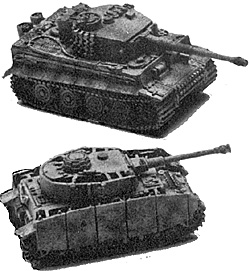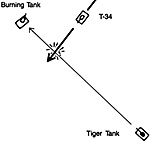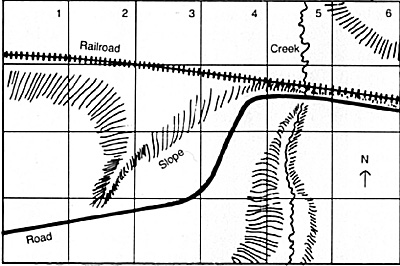A World War II micro-scale miniatures scenario by John Hill, designer of Squad Leader
The Battle of Kursk, the greatest tank battle of World War II, had ended. The power of the German panzers appeared broken forever on the Eastern Front, and Stalin was determined to follow up on the Russian victory in July and sweep the Ukraine clear of the Nazi invaders.
 Tiger I (above) and Panzer IV (below) by GHQ in 1/285 scale.
Tiger I (above) and Panzer IV (below) by GHQ in 1/285 scale.
However, as the victorious red legions converged on the city of Kharkov in southern Russia, they ran into an unexpected wall of steel composed of elements of 3rd Panzer Division, 6th Panzer Division, and 2nd SS Panzer Division "Das Reich." These battered German survivors of the tank meatgrinder at Kursk stubbornly blocked the Russian advance on Kharkov, the fourth largest city of the Soviet Union. The Russian Commander was General Rotmistrov.
His battle-proven 5th Guards Tank Army was the key force at Kursk, stopping the German SS Panzer Corps at Prokhorovka in the largest single tank battle of World War II. Although it suffered heavily at Kursk, the 5th had been partially replenished, and now, a month later could deploy several hundred tanks against the retreating Germans.
If they were committed all at one place, the T-34s of the 5th Guards could make a breakthrough. Carefully, the veteran general studied his map. Inside the "bubble" forming around Kharkov were the remnants of six German divisions. A daring sweep west of the city with his entire tank army might surround and capture them all, and on the map it looked promising.
His German opponent, commander of Army Group South, was Field Marshal von Manstein, one of Germany's most gifted improvisers who had a reputation as a gambler. He also quietly studied his map and read the reports of the massing armored phalanx of the 5th Guards. Finally, he turned from his map and spoke to his aide, "Ivan will be swinging west take all our tanks, artillery, and assault guns that we have left near Kharkov and mass them west of the city."
As the orders went out one of the staff officers became very nervous as he realized that if Rotmistrov attacked anywhere else, Kharkov and six divisions were doomed.
This time, however, Manstein had guessed right. The German defensive line was along a series of rolling hills near the KharkovBogodukhov railroad line.
The next day, August 19th, the first wave of Rotmistrov' s T-34s came trampling through the sunflowers-and blundered into the barrels of the waiting German guns. Dozens of Soviet tanks turned into the motionless piles of smoking metal.
Rotmistrov was not easily deterred by this setback. The following dawn the Russians attacked again, this time with leapfrogging echelons, and penetrated deep into the German position. The defenders were not dislodged and more dark green T- 34s were burning amidst the sunflowers.
Despite the fact that the battle so far had gone against him, Rotmistrov was not totally displeased. Several Soviet spearheads were almost through the German defensive checkerboard. As soon as darkness fell he had his infantry hand carry fresh ammunition to his most advanced elements. There would be no falling back to regroup, unit organization would be ignored, and at a little past midnight his lead tanks would rush forward and break the last thin line of German resistance.
It was just about midnight when the Germans heard the deep rumble of diesel engines and the slap of wide Russian tank treads against the soft Ukrainian earth. Quickly they wiped the sleep from their eyes and climbed back into their vehicles. Frantically, tank commanders radioed headquarters and pleaded for the artillery to start firing flares ... Ivan had not waited for morning!
The moon was but a sliver and the only light was from still burning tanks from the afternoon battle and the desperate flares of the surprised German defenders. The baffle became an eerie nightmare of steel behemoths that appeared and disappeared in the darkness-seen briefly one moment in the hellish red glow of a burning tank or brilliant flash of a flare, then vanishing suddenly in the black night. The Russians kept advancing; somewhere they would break through.
Somewhere along the railroad line from Bogodukhov to Kharkov it happened. In the darkness a great wave of T-34s scurried through the hard-pressed Germans and raced towards Kharkov with nothing to stop them except a pitifully small mobile "reserve."
This reserve consisted of 13 MkIVs tanks of the 6th Panzer Regiment (3rd Panzer Division) and 9 MkVI Tigers of the independent 503rd Heavy Tank Battalion. With desperate elan they tore into the advancing T-34s, and on a small plateau overlooking the railroad the scenario begins.
HISTORICAL RESULT
The Germans were surprised, and the Russians pushed their attack daringly, but the final night breakthrough was contained and destroyed. Although the Soviets were veteran Guardsmen with excellent tanks, the Russians had only about one radio in every third tank. The Germans had a radio in every tank. Giving the Germans a significant command and control advantage which became crucial in the confusion of a close- range night encounter.
The Russians eventually liberated Kharkov on August 23rd. But the successful German night defense of August 21 st gave Manstein the time to extract six divisions from the closing jaws of the Soviet encirclement of Kharkov.
OPPOSING FORCES
RUSSIANS: Forward elements, 5th Guards Tank Army
- 74 T-34/76 (with 76mm L/42 gun), veteran
crews, 24 tanks have radios.
GERMANS: Elements 6th PanzerRegiment, 3rd Panzer Division
- 13 MkIV (with 75mm L/48 long gun),
veteran crews, all 13 tanks have radios.
Elements 503rd Heavy Tank Battalion
- 9 Tiger I (with 88mm L/56 gun), elite crews,
all 9 tanks have radios
GAME LENGTH & VICTORY CONDITIONS
The game lasts 15 complete turns.
To win, the Russians must destroy all German tanks on the game board and have at least 20 T-34s left by the end of the scenario. At least two T-34s still operating must have radios.
To win, the Germans must prevent the above.
RECOMMENDED RULES
Squad Leader/Cross of Iron: Although a board game system, it works well for microscale armor miniatures by defining "one hex" as "one inch." Miniatures rules systems that can be used include: Tank Charts, Angrief, Tractics, WRG Armor Rules. Other tank vs. tank miniatures rules will work quite well.
SPECIAL RULES
Elite Crews: Elite crews can "shoot" better and are more skillful at using even the smallest fold of ground as additional cover. When elite crews fire or are fired upon, they get a die roll modifier benefit of 1" if a two dice combat system is used, or "10" if a percentile dice system is used.
Russian Radios: Prior to the start of the scenario, the Soviet player writes an "R" on the bottom of 24 of his tanks to indicate they have radios. The German player would not know which of the Russian tanks have radios, but to prevent arguments, the Russian player must tell the German player when one of his radio tanks is knocked out.
Command Control: At the start of every turn, the side with the most operating radio tanks on the game table has "command control superiority" and that player may choose which side goes first in the turn sequence for that turn. For example: In most game systems, a turn has a "German Phase" and a "Russian Phase" in which that side may move and perform other actions. If the German player has command control superiority for two consecutive turns, he might choose to play those turns as follows:
- Turn One: Russian Phase, German Phase
Turn Two: German Phase, Russian Phase
This could give the German player an advantage with back-to-back phases rather than the usual alternating sequence.
Night Visibility: If the miniatures game system you use doesn't have specific night combat rules, use the following rules:
- 1 You may only fire at what is "visible."
2. Visibility is defined as:
- a. Target is within 6 inches of firing tank
b. Target is within 3 inches of a burning tank
c. Target is within 1 foot of die marking a flare
d. Target is silhouetted by a burning tank (see diagram of silhouette situation)
German Flares: At the beginning of every turn, the German player may call for a flare. To see the effect, he rolls one six-sided die onto the gaming table. If the roll is a 1," "2," "3," or "4" the flare occurs at the point where the die lays and everything within a one foot radius of the die is visible for the entire turn.
NOTE: Command Control/Turn Sequence is resolved immediately prior to the flare roll:
Burning Tanks: Before starting the game, take six old beat-up tanks from your collection and toss them randomly onto the gaming table. These represent burning tanks from the afternoon's battle, and will burn throughout the game.
Furthermore, any time a tank is "kiilled" during the scenario, if it was killed by an "odd numbered" (1, 3, 11, 57, etc.) die roll it is also considered to be a burning tank for the rest of the scenario.
GAME MAP AND ENTRY POINTS
Tactical Map: Soviet Entry Procedure
At the beginning of every Soviet Movement Phase, the Russian player rolls three six-sided dice. The dice roll total is the number of T-34s that may enter the table that turn. He then rolls one six- sided die and the number rolled is the "zone" the T- 34s enter at along the North edge of the table. This procedure continues until all 74 T-34s are on the game table.
Tactical Map: German Entry Procedure
The 13 MkIVs of 6th Parizer Regiment enter on the road in the SW corner of the table on the first turn. The 9 Tigers of 503rd Battalion may enter anywhere at the southern edge of the table as indicated on a roll of "1" or "2" using one six-sided die. It is possible the Tigers may never enter the scenario.
Tactical Map: Terrain Notes
Movement up slopes is done at half speed or half movement factors. The gully (dark slope marks) is too difficult for any tank to cross. Tanks may cross the creek at no extra cost. Tanks in the creek may claim hull-down advantage except against tanks on higher elevation. The sunflowers don't affect anything, but they look pretty.
 Silhouette Rule: The T-34 shown is
"silhouetted" as it crosses the Line-of-Sight (LOS)
of the Tiger tank to the burning tank. All three
vehicles shown must be on the same elevation or
on the same slope.
Silhouette Rule: The T-34 shown is
"silhouetted" as it crosses the Line-of-Sight (LOS)
of the Tiger tank to the burning tank. All three
vehicles shown must be on the same elevation or
on the same slope.
The tanks are reprinted with permission from GHQ. John Hill is the designer of Squad Leader and Johnny Reb.
Map

Back to Table of Contents -- Game News #5
To Game News List of Issues
To MagWeb Master Magazine List
© Copyright 2000 by Dana Lombardy.
This article appears in MagWeb (Magazine Web) on the Internet World Wide Web.
Other military history articles and gaming articles are available at http://www.magweb.com